skip to main |
skip to sidebar
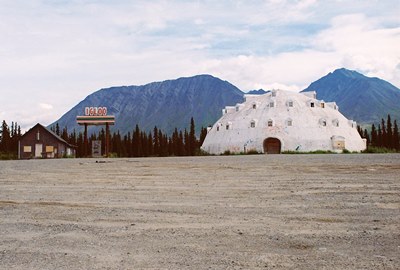
It’s seems like it’s been a very long time since I’ve done a proper post, but I guess it’s only been a month. In that time I’ve been conducting experiments in exhaustion. I like to do this from time to time even though the results are always the same: Days begin to feel like lifetimes, I become very forgetful, and then I get sick. So, here I sit with a cup of a homeopathic Thera-Flu-like drink that will probably have me nodding off at the keyboard while I try to remember where I was in late-July, which might as well have been the 1980’s for how recent it feels now.
Anyway, occasionally City of Dust likes to head further out on the road than usual. Over the past few years we’ve been to Hungary, Germany, and Cambodia. While Alaska might not sound quite as exotic to a North American, it sure feels pretty exotic when you’re there. Sort of like living in Jurassic Park but instead of dinosaurs you get eaten by grizzly bears or trampled by moose and go crazy because the sun never sets. While lots of buildings look derelict, I didn’t find much that was truly abandoned to explore. Probably because the cruel winter destroys anything that’s not regularly tended, unlike out here in the desert. For a while I thought the only thing I might have to report on was the over-the-top level of public intoxication I witnessed in Fairbanks. But then I found an abandoned igloo.
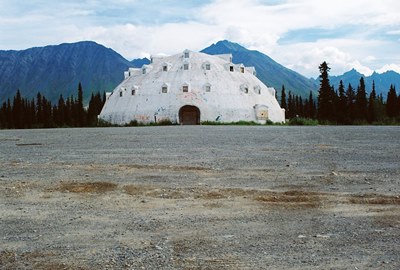
Large enough to be seen from planes at 30,000 feet, the Igloo City Hotel, conceived as a tribute to the Inuit people and built by a man named Leon Smith, was clearly a beautiful idea.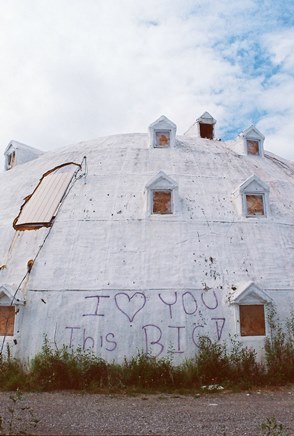 Four stories tall and made of concrete--not ice--with a lovely mountain backdrop, the only flaw in the plan might’ve been building the place 180 miles from Anchorage and almost the same distance from Fairbanks. In fact, it’s way out there on the George Parks Highway, 20 miles from Cantwell (pop. 222), the nearest town. While there is a relatively constant (for Alaska) stream of traffic traveling between Anchorage and Fairbanks, staying at this hotel would’ve put you in proximity to the now-also-abandoned gas station across the parking lot and not much else in the way of civilization.
Four stories tall and made of concrete--not ice--with a lovely mountain backdrop, the only flaw in the plan might’ve been building the place 180 miles from Anchorage and almost the same distance from Fairbanks. In fact, it’s way out there on the George Parks Highway, 20 miles from Cantwell (pop. 222), the nearest town. While there is a relatively constant (for Alaska) stream of traffic traveling between Anchorage and Fairbanks, staying at this hotel would’ve put you in proximity to the now-also-abandoned gas station across the parking lot and not much else in the way of civilization.
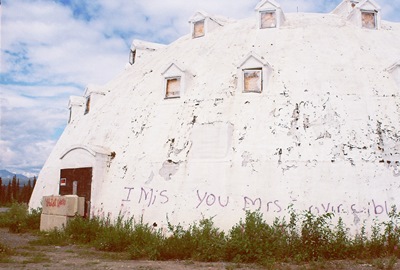
The structure was never close to being completed and the interior is just bare ribs made of hundreds of 2” x 4”’s, which I couldn’t see during my visit because there was nothing but darkness when I poked my head through a loose board. Mr. Smith apparently violated building codes by making the windows too small, started to run out of money, and then was hit by rising fuel costs even before the business itself had a chance of failing. But beyond the tiny windows the structure must’ve been otherwise well-built; the Igloo City Hotel was begun in the 1970’s and has now survived, vacant and exposed, for possibly over 40 Alaskan winters.
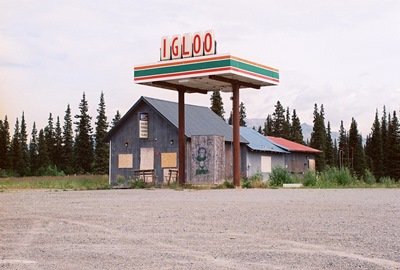
Of course, one man’s dream is…another man’s dream, also, and the Igloo City Hotel was sold a few times only to end up back in Smith’s hands after buyers missed their payments. Before dying, Smith, in failing health and concerned for his wife’s future, finally sold the property to Brad Fisher of Fisher’s Fuel Inc., who didn't actually want it. After Smith accepted his lowball offer, Fisher remembers thinking, "Oh no, that's not really what I wanted to happen!"
Fisher did end up operating the gas station and some adjacent cabins while trying to renovate the hotel, but finally ran out of money himself in the early 2000’s. The gas station and cabins were shuttered in 2005. Mr. Fisher now also has Igloo City, the old gas station, and the surrounding 38 acres up for bid, but will only sell to someone serious about completing the decades-old project.
Hopefully, an enterprising individual will buy the place and give it another chance. Word is that most locals consider it something of a landmark and someday I’d sure like to spend a night in Igloo City. I'd probably need the rest.
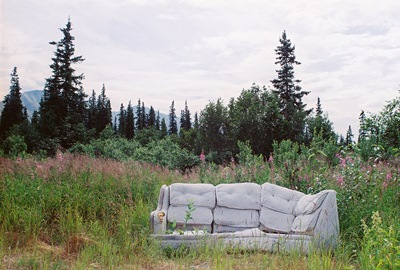
The full story of Leon Smith and his vision of an igloo-shaped hotel in the Alaskan wilderness may forever go untold. But most of the basics have been repeated on several websites that have featured Igloo City, although there are some errors that have proliferated. The best source on the history of the hotel is a STORY from earlier this year in the Alaska Dispatch, which features the quote from Mr. Fisher used above. If you’d like to see the wooden inside of the igloo, Kuriositas has a nice collection of shots.
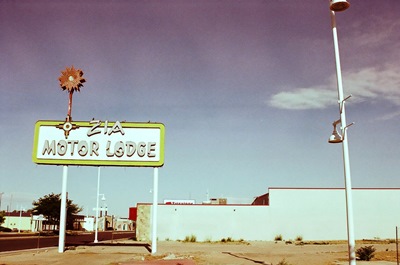
I wanted to break into our regularly scheduled programming for a moment to mention that I was recently invited to contribute to Duke City Fix, a website exploring all things Albuquerque. My first piece several weeks ago was a re-working (read: shortening) of an epic post I did in early 2010 on the Atchison, Topeka & Santa Fe Rail Yards, by far my favorite place to photograph in the city. I followed that up with a companion piece on the WHEELS Museum, a great repository of rail and transportation history and the only actual tenant at the rail yards. My third article, a recounting of a Sunday morning stroll down a battered yet still enthralling Route 66, was published ten days ago. I'm kicking ideas around for the next bit. Let me know if you have any suggestions.
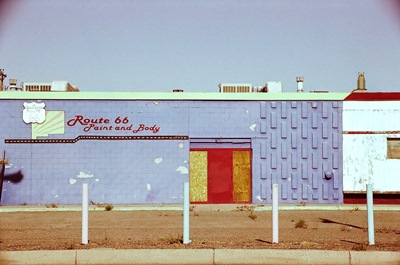
The content of these can be a little different than what I do here, but you’ll still recognize the, uh, aesthetic, I think. If you’re interested in reading more, just follow the links in the text above (2020 UPDATE: Links are long dead). The WHEELS piece features the finest picture of an antique milk truck that I've ever taken. I’d like to thank Duke City Fix for the opportunity. I’m honored to be involved.
The next post will be a one-off stop in Alaska to take a look at a bit of entrepreneurial failure. Seriously.
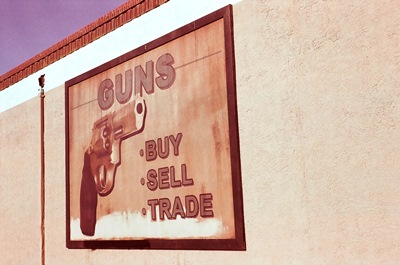
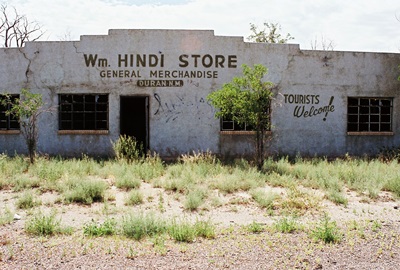
Someday I’ll tell you a tale of a town that didn’t owe its very existence to the railroad, whose citizen’s livelihoods weren’t later subject to the capricious placement of state and federal highways, and which didn’t finally find itself cut-off from the travelers that were its lifeblood. But it ain’t gonna be the story of Duran.
In February 1902, the El Paso & Northeastern Railroad finished the “Arrow Route,” a stretch of track between El Paso and Santa Rosa, where a connection to Leadbelly’s Rock Island Line awaited. Blas and Espiridón Durán, two brothers, owned wells in central New Mexico which could provide water to railroad work crews. So, the railroad built repair shops and even a wooden roundhouse in what became Duran. The railroad also turned the town into an important supply point for area ranches virtually overnight. Duran’s population probably peaked shortly afterward at 300 or so.
But the railroad eventually moved its operations south to Carrizozo and the roundhouse came down in 1921. Yet Duran remained important to ranchers and, when two-lane U.S. Highway 54 came right through the heart of town in the 1930’s, the increased flow of north-south traffic gave Duran another boost. This lasted until the 1960’s, when I-25 was constructed about 60 miles west, strangling U.S. 54 of travelers.
Duran is not a true ghost town. It still has residents--probably around 35, in fact--but two of its most interesting buildings are long-abandoned. One, shown below, is a two-story building made of buff-colored sandstone marbled with white. This was a general store and hotel. Badly faded lettering above the doors reads: “dry goods furniture hardware grocery & feed’s”. It’s still a beautiful building whose quaint façade belies a sinister and surprising history.
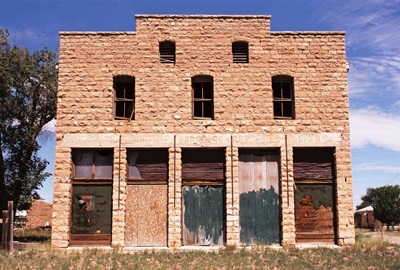
The building was owned by Anton J. Coury, a man of Lebanese descent, who lived with his wife, Raffa, and children, Fred, Anna, and Emma, in the upstairs hotel. On September 3, 1921, the store was robbed by five men and Mr. Coury was shot and killed while resisting. Raffa was also shot and severely wounded, reportedly surviving only because a potentially lethal bullet struck the metal clasps of her corset and was deflected. Young Freddy then bravely intervened, driving away the thieves by relentlessly pelting them with canned goods when their gun jammed. I don’t know if the store ever opened for business again.
A search for the killers began immediately and Francisco Vaisa, Isodoro Miranda, and Carlos Rentenería were quickly caught. Luis Medrano was apprehended some months later. The fifth man, Eziquel Machucha, was never found and it’s believed he escaped back into Mexico.
The prisoners were sentenced to be hung on July 28. 1922, but Vaisa appealed his conviction and bought himself some time. On the appointed day, in Estancia, about 40 miles northwest,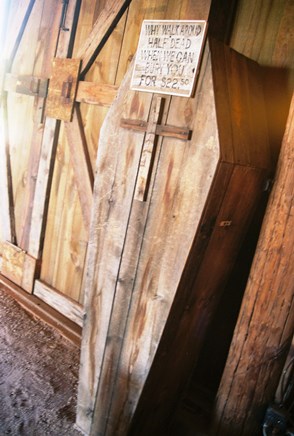 with Mrs. Coury and her children observing, the other three men were brought to the scaffold as the sun rose in the east. Asked for final statements, Rentenería said a few unrecorded words and Medrano said nothing. But Miranda said, “In New Mexico, there is no justice for the poor man. He is led like a helpless lamb through the courts and to his punishment. This is an injustice you are now doing.” Then Sheriff John Block led the men behind a canvas drape, the low sun casting stark silhouettes against the fabric. The day broke in earnest as the men dropped to their deaths.
with Mrs. Coury and her children observing, the other three men were brought to the scaffold as the sun rose in the east. Asked for final statements, Rentenería said a few unrecorded words and Medrano said nothing. But Miranda said, “In New Mexico, there is no justice for the poor man. He is led like a helpless lamb through the courts and to his punishment. This is an injustice you are now doing.” Then Sheriff John Block led the men behind a canvas drape, the low sun casting stark silhouettes against the fabric. The day broke in earnest as the men dropped to their deaths.
It didn’t take long for Vaisa’s conviction to be upheld and, on April 6, 1923, he, too, was brought to the gallows in Estancia. With few observers and after offering that he had no final statement to make, John Block adjusted Vaisa’s noose, the trap door opened, and Vaisa fell as the sun again crested the horizon. He was the 75th and last person to be legally hanged in New Mexico.
Here at City of Dust we like to get our facts straight, which is difficult with the internet around. The more commonly cited story of the above attack includes four robbers striking in the dead of night, with three men being hung and the fourth getting the electric chair. Also, the robbery occurred in 1914. Is the devil in the details? Well, the story I recounted is clearly better and, while I wasn’t there, that version is from “Myth of the Hanging Tree: Stories of Crime and Punishment in Territorial New Mexico,” by former New Mexico State Historian Robert J. Torrez. Mr. Torrez cited contemporaneous editions of the Estancia News-Herald and seems pretty reliable to me.
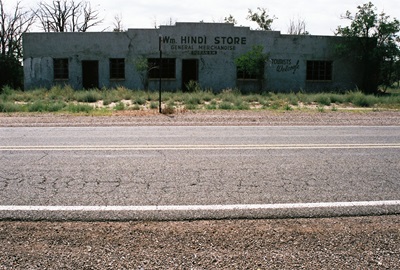
In any case, William Hindi was also from Lebanon and operated a store in Duran, the eye-catching building above and at top, which opened in 1908. It is also constructed of cut stone and its signage still clearly welcomes tourists, but much in the world has moved on while the little store has stood still. At least the graffiti inside, some of which reads, “go hug someone,” “god rox,” and “satan is gay,” would lead one to envision a history far more whimsical than that of the general store. William's brother, Kasim, also operated a store, but his was across the highway from the Coury Merc. Co.
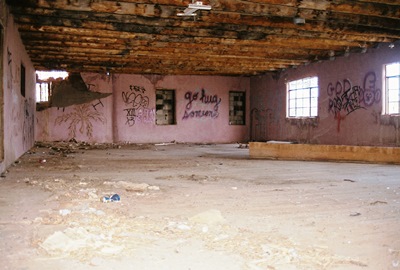
Other buildings around Duran are still in use, including the San Juan Bautista Catholic Church, built in 1910, the red brick school, which closed in 1955 but has been re-purposed as a community center, and the fire station and post office. Thus, unlike some other towns where the trains now whistle right by and motorists are few and far between, Duran persists. It also most certainly sees fewer hanging crimes.
The jumbled tale of the robbery of the Coury family may have originated with a resident of Duran and is retold at ghosttowns.com. To read the more academic version, see Torrez. There is also an odd tale of a boy from the East Coast hitchhiking back to Duran in the 1960’s and starting a life. And that’s everything I could find about Duran. Oh, and the shot of the coffin is from Apacheland Movie Ranch in AZ, not Duran.
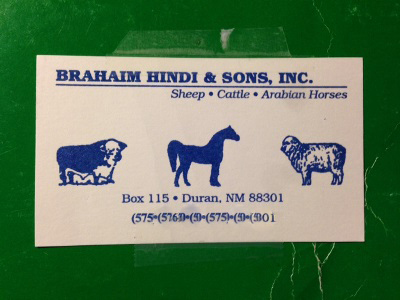
APRIL 2014 UPDATE: I received a very interesting message regarding the Hindi's from Tere O., who has kindly agreed to allow me to post it here. Some of you with roots in Duran might find this of particular interest. Thanks, Tere!:
"Wow, I wish you could have visited with Brahaim Hindi (card above). He lived in Duran and would have been a lot of help with information. Somehow I want to say he has a brother named William but I’m not sure. I’m trying to recover information about Duran for my family that is growing up and they are interested in our history.
"We went to see Brahaim Hindi about a year ago. My mom knows him very well. My Aunt Sara worked for the Hindi’s for years in Duran. She helped raise the children, too. My mom, Agneda, is living with me now but she has dementia and cannot remember much. However, she knew that Brahaim lost his wife and son on the same week and wanted to pay her respects to him so I took her to his house to see him.
"Now he has become quite ill and is living here in Albuquerque with his daughter, or so I hear. I live on the same street as Apolonio S. and his wife, Sandra. He was the postmaster in Duran. I am the granddaughter of Simplicia and Lazaro Montoya. I just posted the coat of arms of the Montoyas on my Facebook page yesterday.
"Hope this info helps you on the journey you have to keep all of us informed."
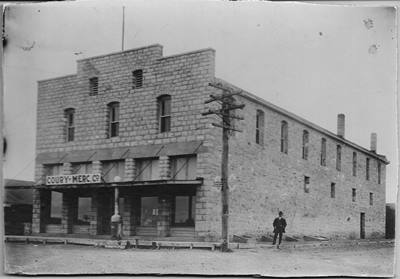
APRIL 2014 UPDATE: After the update a few days ago from Tere O. we get another, this time from S. Hindi, who clears up the picture of Duran, the Hindi family, and who owned (or owns) what store entirely. We also get a great photo of the Coury Merc Co. Incredibly, that is Anton Coury standing at the side. Here is the story:
"The picture (above) is of the Coury Mercantile/boarding house with Anton Coury out front. My husband, Joseph Hindi, bought this building from Raffa Coury, widow of Anton who was shot inside. I have a lot of info on the shooting.
"Also, the William Hindi building across the street was owned by my husband's uncle, Brahaim. William is Brahaim’s uncle. William and Alex Hindi came from Lebanon. The town, Duran, is named after my husband’s grandmother's family. Alex married Clarita Duran and had Brahaim, Sam, Nabay, Shafie, Ednen, Samia, and Hafiza. Shafie is my husband's father.
"Alex became a rancher/Arabian horse breeder and William had the store. Kasim also had a store and is related. There are lots of Hindi’s from Duran. All related. You need to talk to my husband because I may have some of the connections wrong. I’m trying to write a screenplay on the shooting in Duran."
That's an impressive summary. Many thanks for straightening all that out, S. Hindi! Your contribution is very much appreciated. And I really look forward to hearing more about that screenplay. JM
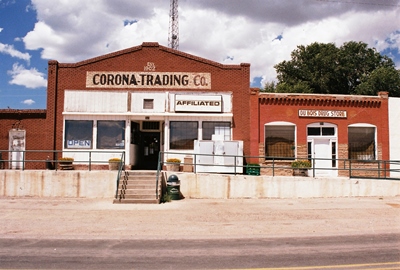
MAY 2014 UPDATE: W.B. Hindi recently sent me a message adding even further detail to this story, particularly William Hindi's background before he opened his store in Duran. Mr. Hindi kindly agreed to have his recollections posted here for all to read:
"I came across your blog on the internet concerning my grandfather’s store in Duran, N.M. My name is W.B. Hindi. My grandfather’s name was Milhelm Hindi, which he changed to William sometime after he arrived here from Lebanon at the turn of the 20th century. When he first got here he actually sold goods out of a buckboard. He sold them in Northern N.M. and into Southern Colo. He bought them from the grandfather of the Maloofs who at one time owned Coors distributing in Albuquerque N.M. I have a picture of him on horseback in front of the Maloof store in Las Vegas N.M.
"His brother, who people are calling Alex, was actually named Ali. William brought Alex over to become his partner in the sheep and cattle business. Since they settled in Duran, which bordered Lincoln County, shortly after the cattle wars of Billy the Kid fame, this may have been the reason he elected to raise both sheep & cattle. He also started breeding Arabians for ranch work and would often take a few along into northern N.M. to sell. There are books that I believe Brahaim has that trace many Arabians in this country back to their heritage from The Hindi Ranch.
"I am still picking my uncle's brains to get more of our history while I can. I am going to forward your blog to my Uncle Azeez and he may possibly be able to fill in some more gaps."
Those are some great pieces to have added to the picture and we're beginning to learn a lot about the origins of the store at the top of this post. Many thanks to W.B Hindi for being so helpful and generous.
By the way, the Corona-Trading Co. and Du Bois Drug Store, shown at the top of this update, aren't in Duran, but Corona, which you'll find a few miles to the southwest on Highway 54. Established in 1902, six years before the Wm Hindi Store, I imagine the Hindi family would've known the Corona-Trading Co. well (and perhaps still do!).
JULY 2014 UPDATE: I'm sorry to report that the Corona-Trading Co., pictured just above and now shown just below, in operation since 1902, has recently closed. Hopefully, I'll be able to do a full post on Corona, NM someday, but, for now, here's to hoping someone buys the old trading company and starts watering those flowers again soon.
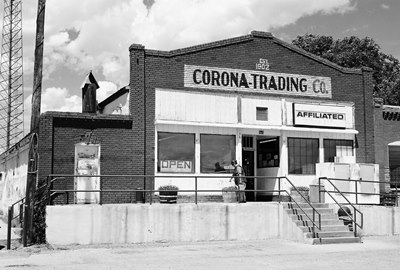
JUNE 2015 UPDATE: I received a great historic photo from W.B. Hindi which, while not specifically of Duran, is certainly Duran-related. I'll let Mr. Hindi explain further (see MAY 2014 UPDATE for more from Mr. Hindi, including a reference to the shot below):
"This is a picture of my grandfather, William (Milhelm) Hindi, loading supplies in 1910 in Las Vegas, NM. He is the gentleman on horseback. I think this is a great photo as it mixes the old (wagon and horses) with the new (motorcycle). I just wish I knew more about it. What is really neat is that Maloof's store was owned by the grandfather of the Maloof's from Albuquerque, whose dad built a small liquor store up into the largest Coors distributorship in the Southwest."
Thanks for the rare and wonderful photograph, Mr. Hindi!
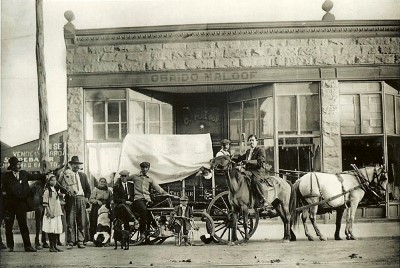
JULY 2015 UPDATE: Below is another wonderful vintage photograph, this one from N.E. Welch. According to the labels on the picture, it depicts the wedding of Mrs. Dan Kelly (far right; née Nova Simpson), occurring in December 1910. Other women in the photo are Mrs. A.E. Simpson (center, in black), Miss Alia Blair (second from right), and Miss Myrtle Estus (far left). The drug store/post office and Duran Eating House, which the Simpson family operated, were on the north side of the railroad tracks, just west of the Coury Merc Co. One of the Simpson children, William, or "Bill," was sheriff of Luna County when Pancho Villa made his raid on Columbus, NM. Note the snow on the ground. The original photo was donated to the Museum of New Mexico in Santa Fe by Mr. Welch's older brother.
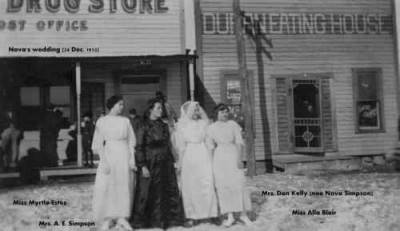
NOVEMBER 2015 UPDATE: Ian Wheeler of Australia has graciously submitted a couple photos from his trip through Duran in the mid-1990's. The first shot is of the mysterious Kasim's Cash Store in all its still-signed glory, complete with vintage gas pump. William, who owned the general merchandise store at the top of this post, was the brother of Kasim's mother and thus Kasim's uncle. Kasim's Cash Store still stands, but has been painted over and is therefore harder to identify, not to mention less interesting. Now we've got photographic evidence of both stores as they were and the full story of just who owned which. The second photo is obviously of the Coury Mercantile Company, but with its doors and windows in rather more authentic condition.
Many thanks to Mr. Wheeler for digging these out and passing them along!
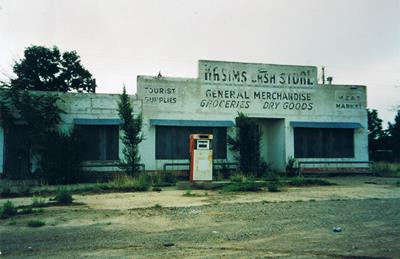
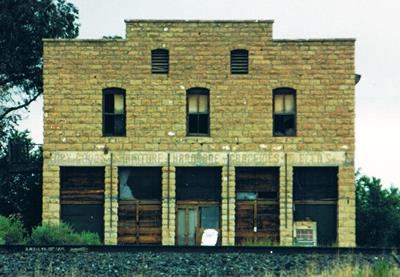
JANUARY 2016 UPDATE: What we have below is a Tokheim 39 gas pump that was made in November 1946 and was once somewhere in Duran. It was purchased in Alamogordo, NM in 2015 and is now in Germany, believe it or not. As you can see, it still has the original Conoco design. If anyone remembers where this pump used to be located (or perhaps even has a photo of it!), please leave a comment below. Both its current owner and myself would love to know! It's a nice one, eh?
Thanks to Bernd for submitting this little bit of Duran highway history.
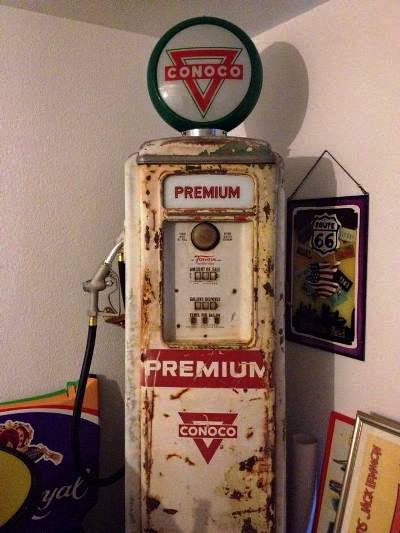
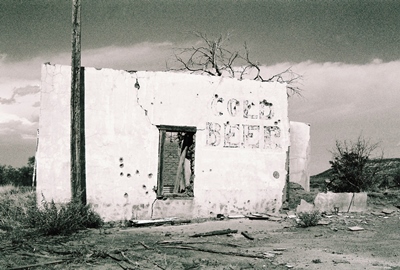
If you drive east of last post’s featured town of Newkirk on old Route 66, at some point you will cross what was once the Goodnight-Loving Trail, one of the most famous cattle drives of the American West. In the mid-1860’s, thousands of cattle and somewhat fewer cowboys began to travel this route from central Texas to Fort Sumner, New Mexico, not 50 miles south of Newkirk. Soon the trail was extended to Denver and then Cheyenne.
The Goodnight-Loving Trail would encompass one of the West’s great stories when, in 1867, Oliver Loving, the trail’s namesake alongside Charles Goodnight, was undertaking an ill-advised daytime ride during a cattle drive from Texas to Fort Sumner, straight through Comanche country. He was accompanied by a young colleague named “One-Armed” Bill Wilson. The two were indeed attacked, not far from Carlsbad; Loving was shot, and after lying near the Pecos River for a couple of days while Wilson heroically went back to alert Goodnight, would develop gangrene in his arm. Loving crawled back to the trail and was finally taken to Fort Sumner by Mexican traders, but allegedly the local surgeon hesitated to amputate as he had never removed a limb. Goodnight arrived and insisted that the arm be removed, but it was too late and Loving died shortly afterward. This tale is largely retold in Larry McMurtry’s famous—if fictionalized—Lonesome Dove.
You won’t see as many cattle now, but you’ll want to keep your eyes open for Montoya because, if you blink, you might miss it. There’s just not much left. Originally a sparsely populated village known as Roundtree, Montoya’s story begins as we’ve seen many, many times here at City of Dust. That is, it was brought to life by the power of the railroad. Thus, Montoya was officially founded in 1902, when it became a center for shipping and freight on the Southern Pacific.
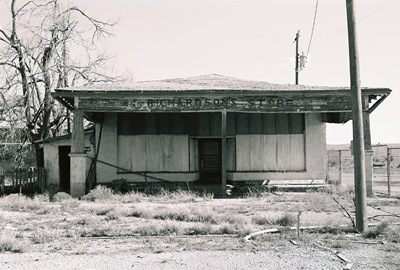
Richardson’s Store and Sinclair Station, pictured above, is one of a couple iconic buildings that remain in Montoya. It opened in 1925, the year before Route 66 was established, and would’ve served countless travelers. Maybe my uncle made a stop on his trip from the Midwest to California back in the '50’s. The store survived into the mid-1970’s, when it was finally locked-up with all the unsold merchandise inside. After the owner died in the early-1990’s, Charles B. Dominguez, a family friend, was asked to watch over the place and its still-unsold contents for a few weeks. Dominguez ended up minding the store for at least 10 years, never selling a thing. What has happened since then I can’t say, but Richardson’s Store is now empty of salable goods and the vintage gas pumps are gone.
The old bar shown below and at the top of this post is perhaps the most-photographed building in Montoya. Unfortunately, I can’t find a thing about its history. If you know something, please leave a comment. It sold beer and someone took a few shots at it, that much is clear.
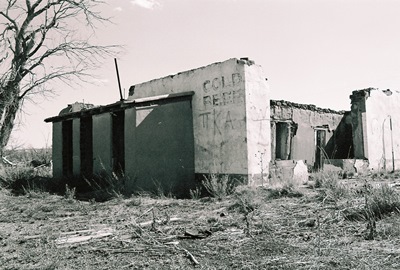
There is also a two-story house made of rock constructed by Sylvan R. Hendren and Maria Ignacia Ulibarri Hendren in the early 1900s. Containing a kitchen and living room on the lower level and two bedrooms upstairs, it was known as Casa Alta (i.e., “High House”). It has a distinctive sloping roof used to catch rain for a cistern, but you’ll have to take someone else’s word for it because I didn’t actually see it. Like I said, blink and you’ll miss it.
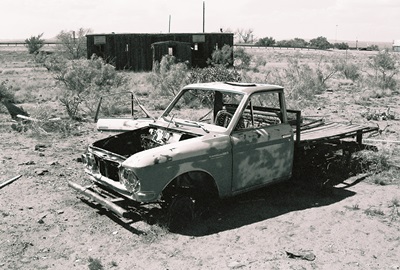
Route 66 from Montoya to Tucumcari, the next town to the east, is narrow and often flooded after rain. In fact, I had to get out and throw rocks into the water at the lowest points of the road to make sure we wouldn’t be submerged in our large sedan. A narrow, one-lane tunnel eventually takes you to the south side of I-40 and, as you hope that any oncoming traffic, however unlikely, is paying attention, it’s hard not to wonder if Route 66 was always this difficult and dangerous. Probably it was much worse. That's an outtake from nearby Cuervo above.
More information on the Goodnight-Loving Trail is on Wikipedia. Between them, Legends of America and Ghosttowns.com contain most of what little information is available on Montoya. But The Road Wanderer has the most interesting piece. It includes a short interview with Charles B. Dominguez which I excerpted and for which I thank the Wanderer.
Next time we’ll go somewhere else.
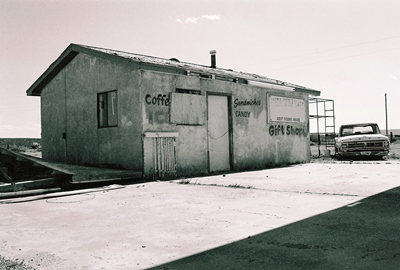
Newkirk, New Mexico is a bit of an enigma. It doesn’t show up in ghost town guides--probably because a handful of people still live there--but this old stopover on Route 66 consists mostly of abandoned gas stations and stores from the days when the Mother Road kept a steady flow of paying customers coming through. In fact, the only going concern in Newkirk now, as far as I can tell, is the Phillips 66 station where old Route 66 meets the I-40 off-ramp. Strangely, Newkirk used to have a Facebook page with 0 “likes” and “0 people talking about this.” Well, I like Newkirk and we’re going to talk about it right now. The shot above is actually from the south side of I-40, before you cross over the highway to Newkirk.
Founded in 1901 with the construction of the nearby railroad, Newkirk was originally known as Conant, the name of a rancher in the area.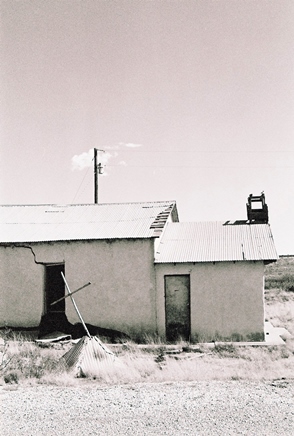 The name was later changed to Newkirk, in honor of a town in Oklahoma from which a resident hailed. Route 66 began to bring people to Newkirk in the 1930’s, when the population reached 240 residents. But, by the 1940’s, despite having four gas stations, two restaurants, De Baca’s Trading Post, a post office, and some rental cabins for travelers, the population was back down to 115. Here is the church, on the ground is the steeple. Have a look inside--no people.
The name was later changed to Newkirk, in honor of a town in Oklahoma from which a resident hailed. Route 66 began to bring people to Newkirk in the 1930’s, when the population reached 240 residents. But, by the 1940’s, despite having four gas stations, two restaurants, De Baca’s Trading Post, a post office, and some rental cabins for travelers, the population was back down to 115. Here is the church, on the ground is the steeple. Have a look inside--no people.
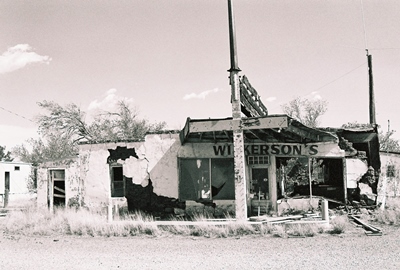
Wilkerson’s Store (pictured above) survived for many years after the decimation of Route 66 by Interstate 40 in the 1960's. Of course, interstate bypasses, such as those that cut-off Newkirk and nearby Cuervo, led to the collapse of the economies of many small towns that depended on travelers. The store was open until 1989, when the Wilkerson family finally had to walk away. It was a Gulf Station, though you couldn’t tell that now. Collapsing adobe is slowly bringing the building back to earth.
Reportedly not open nearly as long but now holding up better is the old post office/gas station/store shown below. Built in 1910 with large stones, it must’ve been fairly bustling for decades. Kinda hard to imagine now. It still retains a good bit of its dignity though and is my favorite building in Newkirk.
I’ve seen references to an old bar and restaurant called Carlo’s Place and an ancient Shamrock Gas Station, but either they’ve fallen down or I missed them. Either way, no photos. There are also the remains of a store which sold, “figural bottles.” Apparently these were bottles made into the shapes of…figures.
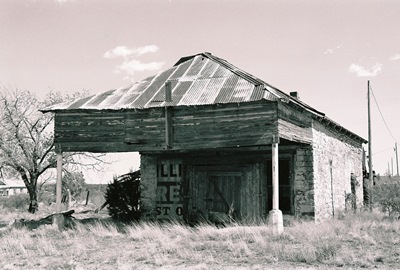
These days Newkirk seems to have largely returned to its ranching roots. But perhaps things aren’t as pastoral as they seem. A photographer I know was standing on the side of old Route 66 with her camera earlier this year when a NM state trooper raced up and told her she was “in danger.” “People around here shoot first and ask questions later,” he said, before speeding away again.
My visit was much less dramatic and included a stop at the Phillips 66 to buy an iced tea, ask a question of the owner, and pet his massive German Shepherd. However, with the NM State Police recently calling I-40 a “River of Crime,” with an astounding 1-in-7 vehicles possibly involved in criminal activity, not to mention whatever the hell is going on in Cuervo, perhaps the residents of Newkirk are right to be on edge. If you’re planning to visit, best be prudent.
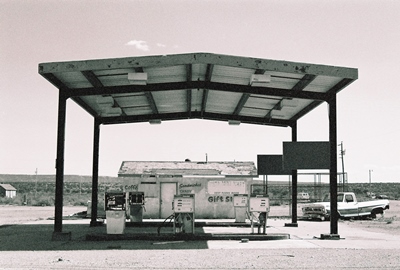
There used to really be only one source for information on Newkirk, The Road Wanderer, a Route 66 aficionado who did a nice piece on Newkirk in the early 2000’s. But last month Legends of America added a page on Newkirk, too. Historically-speaking, they both kinda say the same things. So, yeah, I just regurgitated that info here. If you want to "like" Newkirk’s Facebook page, you used to be able to go HERE, but not anymore.
Next time we’ll head a few more miles east down old Route 66, across flooded roads and under narrow bridges, to Montoya, NM, where there are even fewer kicks.
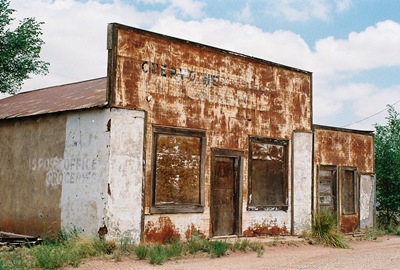
When it comes to ghost towns, it doesn’t get much better than Cuervo, New Mexico. Its condition is remarkable not just because the town is no secret, as any internet search will attest, but because it’s literally feet from Interstate 40. Clearly, most people on the road between Albuquerque and Tucumcari don’t stop for a visit. Either they don’t know about Cuervo or they don’t care. That’s fine with me, although it doesn’t quite keep all the riff-raff out, as I’ll explain later.
Pulling into desolate, (mostly) deserted Cuervo is like driving into the apocalypse, if the apocalypse happened in 1920. Just forget about the semis whizzing by on I-40 and there are only old cars and older houses, scraps of clothes and newspapers from decades ago, everything in that hauntingly arrested state that all aficionados of the lost desire.
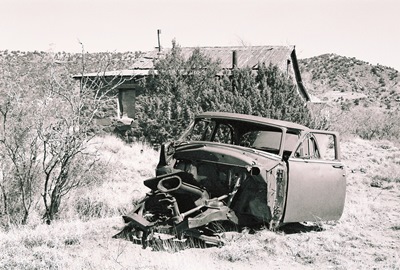
It’s always useful to know the names of places, regardless of the language they’re in, and that’s true in Cuervo. The town’s name means “crow,” (or, alternatively, "raven") and while there may have been many of these dark birds around at one point, not a single one was seen on our visit. Perhaps they were hanging out on nearby Cuervo Hill, the town's namesake. Or, maybe, unlike us, they were simply smart enough to stay out of the relentless heat of the midday sun.
Like so many others in New Mexico, Cuervo was a railroad town, brought to life about 1902 when the Chicago, Rock Island, and Pacific Railroad came through and turned the little outpost into a water stop. Before that, the town site had been on a trade route in use since at least the early 1500’s, but no one had previously thought to try to settle down way out on the wide and lonely plains.
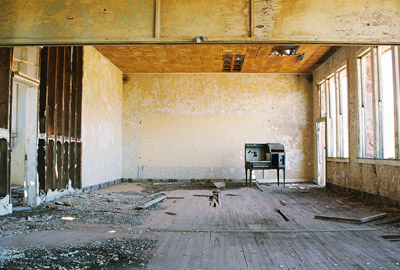
Cuervo started off with a bang as an expansion of cattle and sheep ranching swept through the area in 1910. A couple decades later, Route 66 ran straight through town, easily supporting the few gas stations and hotels that sprang up in its wake. At its height, Cuervo had two of everything a person could want: schools, churches, doctors, and hotels.
One school, built around 1930 and closed in 1958, stands alone in a field of red dirt and was the high point of this visit to Cuervo.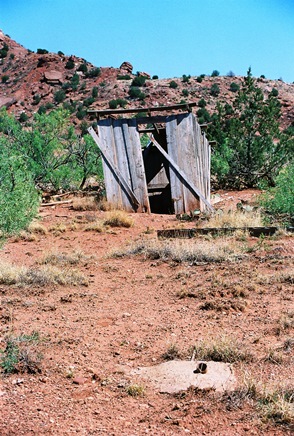 It might have been purchased by an elderly lady last fall for $10,250, though I’m not sure if the sale actually went through. That's the old outhouse to the left and classroom above. Also, both churches are extant. The Catholic church on the south side of I-40 was built of red sandstone during WWI. It’s well-maintained to this day. The Getty Memorial Baptist Church, on the north side, represented the low point of our trip. Again, I’ll explain shortly.
It might have been purchased by an elderly lady last fall for $10,250, though I’m not sure if the sale actually went through. That's the old outhouse to the left and classroom above. Also, both churches are extant. The Catholic church on the south side of I-40 was built of red sandstone during WWI. It’s well-maintained to this day. The Getty Memorial Baptist Church, on the north side, represented the low point of our trip. Again, I’ll explain shortly.
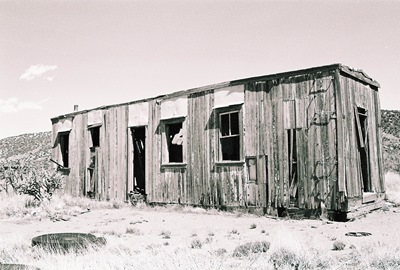
As with dozens of towns that owed their existence to the railroad and Route 66, the construction of the interstate system was a death knell. In the case of Cuervo, in the late 1960’s, I-40 was put right through the center of town, probably turning the lives of many residents into something like a John Mellencamp song.
But it’s worth bearing in mind that Cuervo was never a metropolis. Its population in 1946, immediately post-WWII, was only 128. In 1981, Philip Varney reported in New Mexico’s Best Ghost Towns that many homes remained occupied. Its population now may be in the single digits, including the owner of the non-functioning gas station on the north side of I-40. If you came to take pictures, I hear he won’t be happy to see you. He may well have good reason.
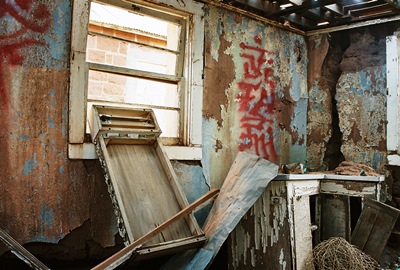
Now, over the years, I’ve occasionally gotten letters from people asking how they can access the places I’ve photographed. In every case, I’m careful to point out that I don’t want to encourage people to visit these sites, mostly for their own safety. Save it for people with unhealthy compulsions. Like me. Sometimes there is the problem of trespassing. But, in the case of Cuervo, which, as I mentioned, isn’t exactly unknown to explorers, very few buildings are posted as private property. In fact, aside from falling through a floor or having a roof cave in on you, the main danger in abandoned buildings is other people.
In every case, I’m careful to point out that I don’t want to encourage people to visit these sites, mostly for their own safety. Save it for people with unhealthy compulsions. Like me. Sometimes there is the problem of trespassing. But, in the case of Cuervo, which, as I mentioned, isn’t exactly unknown to explorers, very few buildings are posted as private property. In fact, aside from falling through a floor or having a roof cave in on you, the main danger in abandoned buildings is other people.

On that note, as of a few weeks ago, I can report that the Getty Memorial Baptist Church (pictured above) contains the most alarming installation I’ve seen since someone hung a rabbit at the Clearwater Textile Mill in 2004. So, if you ever find yourself wanting to check out the old Baptist church, drop me a line and I’ll tell you EXACTLY why you shouldn’t. Sorry, can’t post a photo of this one…or even describe it. Let's just say that there's evidence of return visits and an encounter could well go badly.
Alright, enough of that. I didn't know that Philip Varney recently released a new ghost town book! It was even in the Huffington Post. Of course, his NM ghost town guide was my primary source here. I also got a few tidbits from Ghost Towns Alive by Linda G. Harris. A little more background was plucked from Legends of America. The factoid about the woman who bought the old school came from a website called Topix but it's gone now.
Next time I think we’ll head down old Route 66 a couple miles to Newkirk and Montoya.
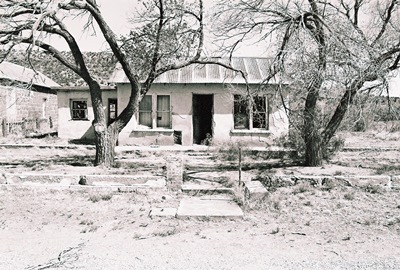
NOVEMBER 2014 UPDATE: Since I published this post 16 months ago I've probably answered a couple hundred inquiries about just what was in the Getty Memorial Baptist Church. I even developed a form letter response that I would revise as information came in. But now I can refer people to KRQE News 13 where THIS PIECE illustrates the scenes at two different locations in the area better than I could describe them here. Although things seem much calmer in Cuervo and there is some consistent activity (the school has been restored and has a nice, new roof!), I'm still not going to encourage people to visit because...there is no real end to the story. Also, to answer another common question, yes, the symbol on the wall in this post has been confirmed as Satanic. But that's almost certainly unrelated to what was in the Getty and elsewhere.
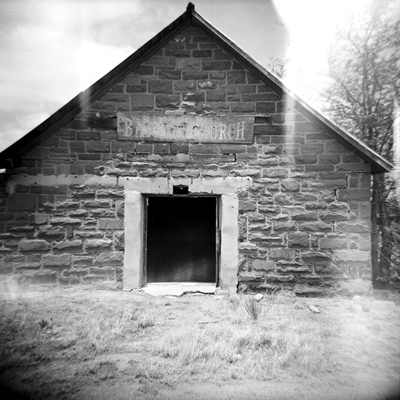
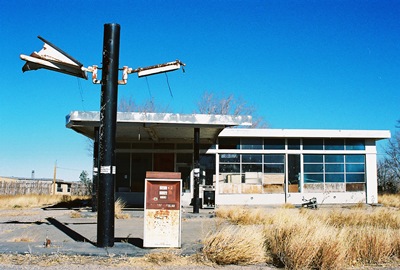
These days Vaughn, New Mexico is probably best known for its police force, which consists of a single drug-sniffing dog named Nikka. Last year there was a police chief, but he owes tens of thousands of dollars in child support and was accused of selling one of the town's rifles and keeping the proceeds. A second officer recently pleaded guilty to assault and battery, but he was never officially certified anyway. That leaves Nikka and the Guadalupe County Sheriff’s Department to keep the peace in Vaughn which, despite it being considered a stopover for drug smugglers, probably isn’t that difficult. But Vaughn, with a population of 438 (down from 539 in 2000), wasn’t always as quiet as it is today.
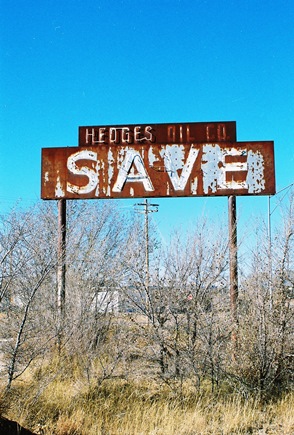 In fact, Vaughn used to rattle and clack quite a bit. That's because by 1905 it was where the Atchison, Topeka & Santa Fe (ATSF) and El Paso & Southern Railroads intersected, the only place in New Mexico where two major railways crossed. It was also a division point for the railroad, with a roundhouse, multiple tracks, and a railroad office. After the arrival of the automobile, it became the town where three US Highways--54, 60, and 285--met.
In fact, Vaughn used to rattle and clack quite a bit. That's because by 1905 it was where the Atchison, Topeka & Santa Fe (ATSF) and El Paso & Southern Railroads intersected, the only place in New Mexico where two major railways crossed. It was also a division point for the railroad, with a roundhouse, multiple tracks, and a railroad office. After the arrival of the automobile, it became the town where three US Highways--54, 60, and 285--met.
But before Vaughn even had a name it was a favored resting place during drives on the Stinson Cattle Trail. Jim Stinson worked for the New Mexico Land and Livestock Company and, beginning in 1882, would bring up to 20,000 head of cattle at a time from Texas to homesteads and forts in the Estancia Valley of east-central New Mexico.
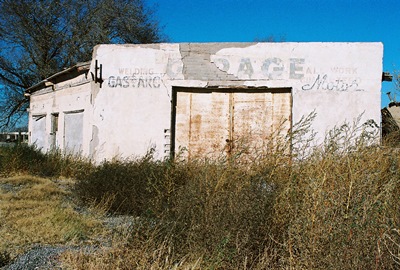
Vaughn got its name from Major G.W. Vaughn, who was a civil engineer for the ATSF. Right off the bat there was a water shortage and, in 1908, the ATSF built a water tank and two underground cisterns to try to collect as much of the precious liquid as they could. Drinking water was brought in by tanker from nearby Willard and Negra. The El Paso & Southern did a little better, having their water transported via wooden pipe from Bonito Lake, 100 miles to the southwest. In 1909, the ATSF figured it would just be easier to pay the El Paso & Southern 24 cents per thousand gallons than try to collect their own water any longer.
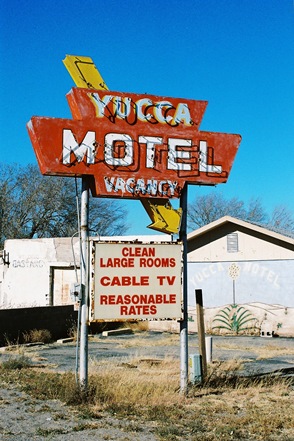 In 1910, the Los Chavez Harvey House opened, named after the Chavez family, who arrived in the area with Don Juan de Onate and the first European settlers in the late 1500’s. The Harvey House in Vaughn served as kind of a minor league team for newly recruited Harvey Girls who were just learning the proper way to look nice and be good. The hotel itself never saw many guests and closed in 1936.
In 1910, the Los Chavez Harvey House opened, named after the Chavez family, who arrived in the area with Don Juan de Onate and the first European settlers in the late 1500’s. The Harvey House in Vaughn served as kind of a minor league team for newly recruited Harvey Girls who were just learning the proper way to look nice and be good. The hotel itself never saw many guests and closed in 1936.
Charles Lindbergh even stopped in Vaughn, but not because he particularly wanted to. In 1928, engine failure forced him to land his plane and wait in town a few days for a replacement part to arrive. He stayed at the Harvey House and, apparently, despite the best efforts of the girls, was not interested in socializing with them in the slightest. To read about another stranded traveler who felt an initial distaste for Vaughn, yet eventually came around, I used to recommend a stop at Viva New Mexico, but it's gone now. However, you can still read the piece if you head over to New Mexico Magazine.
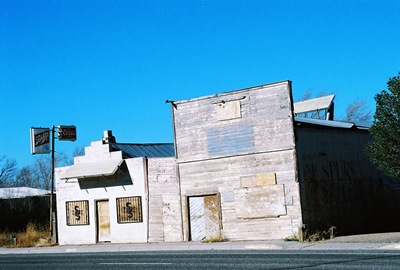
Vaughn wasn’t incorporated until 1919, but by 1920 it had a relatively healthy population of about 1000. However, the number of residents may never have climbed much higher than that. One Harvey Girl, Alice Garnas, said in 1926, “Vaughn was a shocking place. There was no place to go, nothing to do. Just Vaughn and those wide plains on all sides--cattle country. But it was for me.”
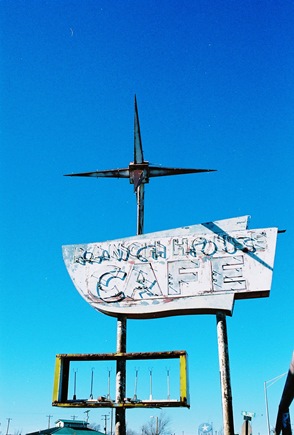 And it might be for you, too. But if, like many, you’re just passing through, try to make a stop at Penny’s Diner. Look for the restaurant at the crossroads that appears to be inside a large aluminum Airstream trailer. Once you enter, it’ll be 1955 all over again and you’ll swear you can hear that clickity-clack as the iron horses rumble through.
And it might be for you, too. But if, like many, you’re just passing through, try to make a stop at Penny’s Diner. Look for the restaurant at the crossroads that appears to be inside a large aluminum Airstream trailer. Once you enter, it’ll be 1955 all over again and you’ll swear you can hear that clickity-clack as the iron horses rumble through.
Like the previous post, on the town of Encino, most of the hard-to-find information and quotes included here came from Dixie Boyle’s excellent book, “A History of Highway 60 and the Railroad Towns of the Belen, New Mexico Cutoff.” Ms. Garnas' quote came from "The Harvey Girls: Women Who Opened the West," by Lesley Poling-Kempes. I also grabbed a bit from Wikipedia, the aforementioned Viva New Mexico, and the LA Times, believe it or not.
Next time we’re going to one of the best ghost towns I know, Cuervo, NM.
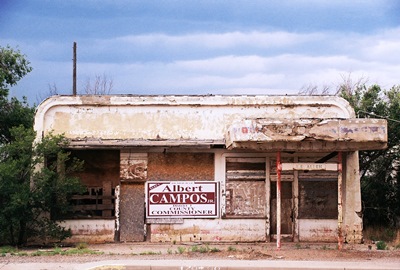
NOVEMBER 2014 UPDATE: A reader recently sent in some postcards and stories about the Sands Motel, which their grandfather built and owned. This history was so extensive that I wanted to present it here. Happily, I was given the go-ahead. So, here's the story of the Sands Motel:
"My name is Dana McElyea and I live in Texas. These pictures are of the Sands Motel in Vaughn that my grandfather Jack Cormany built in the early 1960's. The motel was just as you came into town from the west. We spent every Christmas and summer traveling there when we were young.
"My grandfather was an incredible man that could do anything. He had several inventions and had Dr. Pepper bottling companies at one time before the motel. He moved to Vaughn for the climate and built the motel there due to the intersection of highways. I still have linens and dishes from the motel and the cafe.
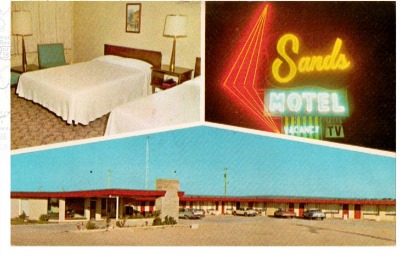
"He sold the motel and moved to a 17-room house there in Vaughn that used to be a clinic from what I understand. That was farther down the street, right next to a church that was on the corner. It was a really nice house. They had named each of the 17 rooms, some according to what they had been when it was a clinic; baby room, waiting room, blue room, book room. The house had a beautiful rock fireplace that covered a wall. It really was beautiful inside for Vaughn. ;)
"Me and my two older brothers used to play in the glass enclosed check-in office at night. We would turn out all the lights and when a car drove past on the highway we would see who could 'hit the deck' the fastest before it saw us. Ha! If you look close on the far right side of the motel there’s a cement pad. That is where my brother shot me in my little toe with a BB gun because I wouldn't 'dance' like he told me to. Haha! Many good childhood memories in Vaughn. ;)
"I especially remember how wonderful my grandparents were to anyone staying in the motel. It was more like a bed and breakfast. Sometimes people stayed for days if they were snowed in. I have pictures of the snow up to the roof line and my grandfather having to use his tractor to clear it away.
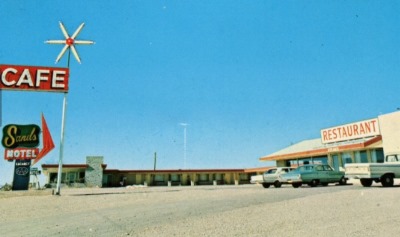
"My grandfather passed away in the late 1970s. My grandmother continued to live in Vaughn until we moved her to Texas around 2000. She has passed as well.
"I read in the comments where someone inquired about the Cassidy family. My grandparents were very good friends with the Cassidy's and I believe they even traveled together some in my grandfather’s trailer.
"I just thought you might like some history on the motel. It was always so nice when my grandfather had it. I have many fond memories of Vaughn. It's heartbreaking to see the condition of it now."
Many thanks to Dana McElyea for sharing her postcards and memories.


 Four stories tall and made of concrete--not ice--with a lovely mountain backdrop, the only flaw in the plan might’ve been building the place 180 miles from Anchorage and almost the same distance from Fairbanks. In fact, it’s way out there on the George Parks Highway, 20 miles from Cantwell (pop. 222), the nearest town. While there is a relatively constant (for Alaska) stream of traffic traveling between Anchorage and Fairbanks, staying at this hotel would’ve put you in proximity to the now-also-abandoned gas station across the parking lot and not much else in the way of civilization.
Four stories tall and made of concrete--not ice--with a lovely mountain backdrop, the only flaw in the plan might’ve been building the place 180 miles from Anchorage and almost the same distance from Fairbanks. In fact, it’s way out there on the George Parks Highway, 20 miles from Cantwell (pop. 222), the nearest town. While there is a relatively constant (for Alaska) stream of traffic traveling between Anchorage and Fairbanks, staying at this hotel would’ve put you in proximity to the now-also-abandoned gas station across the parking lot and not much else in the way of civilization. 







 with Mrs. Coury and her children observing, the other three men were brought to the scaffold as the sun rose in the east. Asked for final statements, Rentenería said a few unrecorded words and Medrano said nothing. But Miranda said, “In New Mexico, there is no justice for the poor man. He is led like a helpless lamb through the courts and to his punishment. This is an injustice you are now doing.” Then Sheriff John Block led the men behind a canvas drape, the low sun casting stark silhouettes against the fabric. The day broke in earnest as the men dropped to their deaths.
with Mrs. Coury and her children observing, the other three men were brought to the scaffold as the sun rose in the east. Asked for final statements, Rentenería said a few unrecorded words and Medrano said nothing. But Miranda said, “In New Mexico, there is no justice for the poor man. He is led like a helpless lamb through the courts and to his punishment. This is an injustice you are now doing.” Then Sheriff John Block led the men behind a canvas drape, the low sun casting stark silhouettes against the fabric. The day broke in earnest as the men dropped to their deaths.















 The name was later changed to Newkirk, in honor of a
The name was later changed to Newkirk, in honor of a 





 It might have been purchased by an elderly lady last fall for $10,250, though I’m not sure if the sale actually went through. That's the old outhouse to the left and classroom above. Also, both churches are extant. The Catholic church on the south side of I-40 was built of red sandstone during WWI. It’s well-maintained to this day. The Getty Memorial Baptist Church, on the north side, represented the low point of our trip. Again, I’ll explain shortly.
It might have been purchased by an elderly lady last fall for $10,250, though I’m not sure if the sale actually went through. That's the old outhouse to the left and classroom above. Also, both churches are extant. The Catholic church on the south side of I-40 was built of red sandstone during WWI. It’s well-maintained to this day. The Getty Memorial Baptist Church, on the north side, represented the low point of our trip. Again, I’ll explain shortly.

 In every case, I’m careful to point out that I don’t want to encourage people to visit these sites, mostly for their own safety. Save it for people with unhealthy compulsions. Like me. Sometimes there is the problem of trespassing. But, in the case of Cuervo, which, as I mentioned, isn’t exactly unknown to explorers, very few buildings are posted as private property. In fact, aside from falling through a floor or having a roof cave in on you, the main danger in abandoned buildings is other people.
In every case, I’m careful to point out that I don’t want to encourage people to visit these sites, mostly for their own safety. Save it for people with unhealthy compulsions. Like me. Sometimes there is the problem of trespassing. But, in the case of Cuervo, which, as I mentioned, isn’t exactly unknown to explorers, very few buildings are posted as private property. In fact, aside from falling through a floor or having a roof cave in on you, the main danger in abandoned buildings is other people.



 In fact, Vaughn used to rattle and clack quite a bit. That's because by 1905 it was where the Atchison, Topeka & Santa Fe (ATSF) and El Paso & Southern Railroads intersected, the only place in New Mexico where two major railways crossed. It was also a division point for the railroad, with a roundhouse, multiple tracks, and a railroad office. After the arrival of the automobile, it became the town where three US Highways--54, 60, and 285--met.
In fact, Vaughn used to rattle and clack quite a bit. That's because by 1905 it was where the Atchison, Topeka & Santa Fe (ATSF) and El Paso & Southern Railroads intersected, the only place in New Mexico where two major railways crossed. It was also a division point for the railroad, with a roundhouse, multiple tracks, and a railroad office. After the arrival of the automobile, it became the town where three US Highways--54, 60, and 285--met.
 In 1910, the Los Chavez Harvey House opened, named after the Chavez family, who arrived in the area with Don Juan de Onate and the first European settlers in the late 1500’s. The Harvey House in Vaughn served as kind of a minor league team for newly recruited Harvey Girls who were just learning the proper way to look nice and be good. The hotel itself never saw many guests and closed in 1936.
In 1910, the Los Chavez Harvey House opened, named after the Chavez family, who arrived in the area with Don Juan de Onate and the first European settlers in the late 1500’s. The Harvey House in Vaughn served as kind of a minor league team for newly recruited Harvey Girls who were just learning the proper way to look nice and be good. The hotel itself never saw many guests and closed in 1936.
 And it might be for you, too. But if, like many, you’re just passing through, try to make a stop at
And it might be for you, too. But if, like many, you’re just passing through, try to make a stop at 

